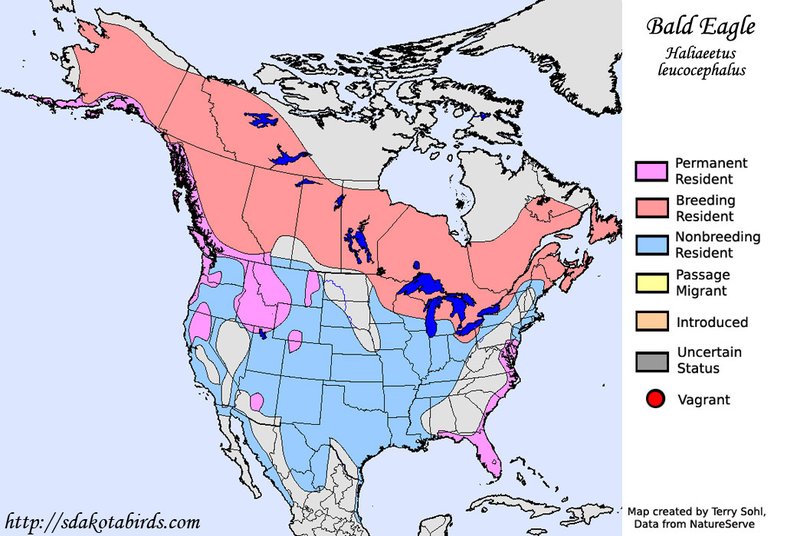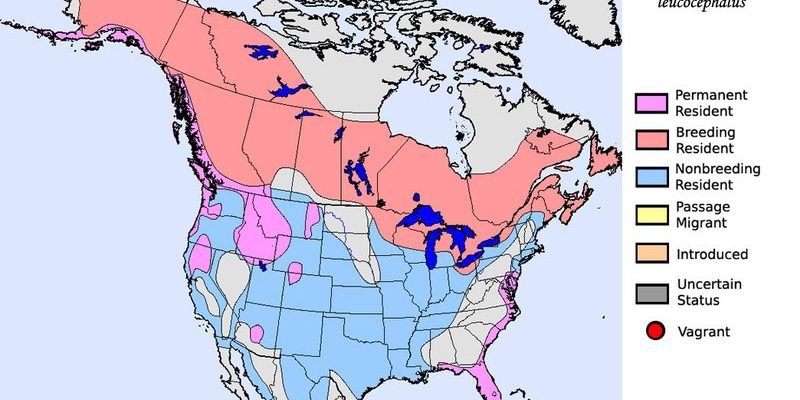
Understanding where to spot these incredible creatures can be fascinating and rewarding. Bald eagles are more than just the national bird of the United States; they have specific preferences about where they like to hang out. This article will guide you through their preferred habitats and ranges so you know exactly where to look. So grab a cup of coffee, and let’s dive in!
North America: The Heart of Bald Eagle Territory
When most people think of bald eagles, they think of North America. It’s like the home base for these iconic birds, where they thrive in various environments. You’ll find them primarily around large bodies of water such as lakes, rivers, and coastal regions. Bald eagles need access to food—primarily fish—so these water sources are vital. They’re frequently spotted perching in tall trees along the water’s edge, keeping a watchful eye for their next meal.
During the warmer months, bald eagles are often found in the northern United States and Canada. In places like Alaska, they can be particularly abundant. The lush landscapes and abundant food supply provide an ideal environment for nesting and raising their young. As regions warm up in spring, these birds migrate from southern wintering areas back to their summer habitats, a journey that can take several hundred miles.
You might be wondering why urban areas are becoming more common spots for these birds. Honestly, as cities expand, some bald eagles have adapted to hunting near man-made ponds and waterways. So, keep your eyes peeled even in urban parks or near golf courses with water features!
Alaska: A Bald Eagle Paradise
Alaska is like the ultimate vacation spot for bald eagles. If you want to see these majestic birds up close, this is the place to go. It’s estimated that around 50,000 bald eagles live in Alaska, which is more than any other state. The vast wilderness areas, combined with rich fishing grounds, make it a perfect home.
Among the top locations in Alaska is Kachemak Bay, where you can find them perched on trees or soaring above the water. Another hotspot is the Chilkat River, especially during the salmon runs in late fall. Picture a scene: hundreds of eagles swooping down to catch fish jumping out of the water—it’s breathtaking and not something you want to miss.
In addition, places like Juneau and Sitka offer guided tours for eagle watching, making it even easier to spot these incredible birds. Local guides know the best spots and can share fascinating insights about their habits and behaviors. It’s like a nature documentary coming to life right in front of you!
The Pacific Northwest: Coastal Habitats
The Pacific Northwest is another prime region for spotting bald eagles. With its dramatic coastlines, dense forests, and abundant rivers, it offers everything these birds need. States like Washington and Oregon are perfect places where they can fish and nest in tall coniferous trees.
One of the best times to see bald eagles in this area is during winter, particularly in places like the Skagit River. Here, the river’s confluence attracts hundreds of eagles drawn by the salmon runs. Imagine walking along the riverbank and seeing these magnificent birds dotting the trees, each one a picture of grace and power.
National parks such as Olympic National Park also provide fantastic viewing opportunities. Along the rugged coastline, eagles can often be seen swooping down towards the water, showcasing their hunting prowess. Plus, the combination of stunning scenery and wildlife makes it a photographer’s paradise!
The Great Lakes: A Nesting Ground
The Great Lakes region is an underrated gem for observing bald eagles. States like Michigan, Minnesota, and Wisconsin have made significant efforts in recent years to protect these majestic birds and their habitats. The diverse ecosystems of wetlands and forests surrounding the lakes are excellent for nesting.
Bald eagles tend to nest in large trees near water sources, and the Great Lakes provide plenty of both. Places like the Apostle Islands National Lakeshore in Wisconsin are particularly notable for their active eagle populations. You can sometimes even see eaglets peeking out from their nests during the nesting season.
Moreover, in the winter months, the open waters of the Great Lakes attract eagles searching for food. They’re often seen fishing along the shores or perched in trees, waiting for the perfect moment to dive. It’s a sight that can make anyone fall in love with nature all over again.
Global Habitats: Beyond North America
While North America is the most famous region for bald eagles, they’re not just confined to this continent. In fact, they can be found across various regions, which might surprise some people. For example, there are populations in parts of Europe, like Scotland, as well as in Asia, particularly in Russia and Mongolia.
In Europe, the white-tailed eagle is often confused with the bald eagle due to its similar appearance. While the bald eagle is primarily found in North America, the white-tailed eagle prefers coastal areas and is a common sight in countries bordering the North Sea, such as Norway and Finland. This demonstrates how diverse eagle habitats can be, adapting to local conditions and food sources.
In Asia, especially in Siberia, bald eagles thrive in the vast wild expanses. They migrate across varying terrains, showcasing their adaptability. This broad range highlights not only the remarkable resilience of these birds but also what they need to survive in different climates.
Conservation Efforts: Protecting Bald Eagle Habitats
Understanding where to spot bald eagles leads us to another important topic: their conservation. Over the years, habitat destruction, hunting, and pollution have threatened their populations. Thankfully, conservation efforts have made significant strides to protect these magnificent birds.
Various organizations work to preserve their natural habitats, ensuring that bald eagles have access to clean water and abundant food sources. Laws in place, such as the Bald and Golden Eagle Protection Act in the U.S., offer protections against harm and harassment. Wetlands are being restored, and nesting trees are being preserved, creating safe spaces for these birds to thrive.
Community engagement is also vital. Many local groups host eagle-watching events and educational programs to raise awareness about the importance of protecting these birds. So, when you’re out eagle watching, think about supporting these initiatives. Every little bit helps in ensuring that future generations can also enjoy seeing bald eagles in their natural habitats.
Spotting a bald eagle in the wild is an unforgettable experience. From the rugged coasts of Alaska to the serene waters of the Great Lakes, these magnificent birds thrive in so many beautiful places. Remember, if you’re eager to catch a glimpse of these incredible creatures, consider visiting their prime habitats during the right seasons.
And now, with a bit of knowledge in your back pocket, you can appreciate not only the beauty of bald eagles but also the importance of preserving their environments. So, whether you’re planning a trip to see them or simply learning about their habitats from home, you’re part of the journey to understand and protect these symbols of strength and freedom. Happy eagle watching!

